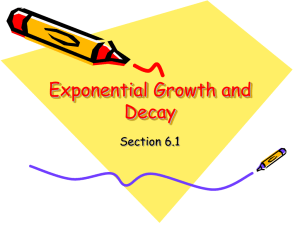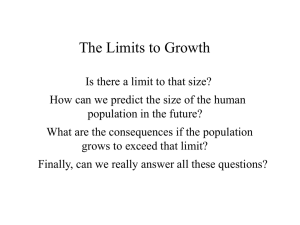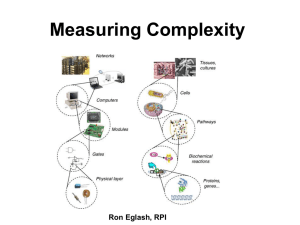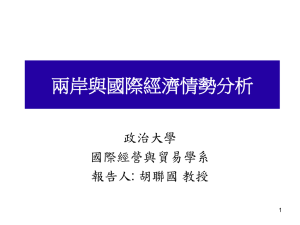Alternative Lesson 6.2
advertisement
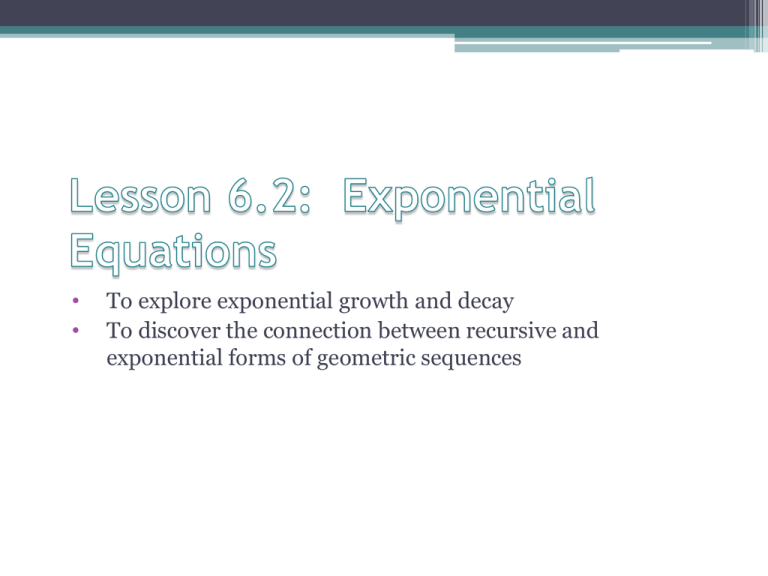
• • To explore exponential growth and decay To discover the connection between recursive and exponential forms of geometric sequences Recursive Routines • Recursive routines are useful for seeing how a sequence develops and for generating the first few terms. • But if you’re looking for the 50th term, you’ll have to do many calculations to find your answer. • In chapter 3, you found that graphs of the points formed a linear pattern, so you learned to write the equation of a line. Recursive Routines • Recursive routines with a constant multiplier create a different pattern. In this lesson you’ll discover the connection between these recursive routines and exponents. • Then with a new type of equation you’ll be able to find any term in a sequence based on a constant multiplier without having to find all the terms before it. Loosing Area in a Square Fractal • In this investigation you will look for patterns in area of a square fractal. Growth of a Rectangular Fractal • To create a fractal we will begin with a 27 x 27 square • This is stage 0. • To create stage 1 draw two vertical lines and two horizontal lines to subdivide the shape into 9 equal parts. Shade any one of the parts to illustrate the square being removed. • To create stage 2 draw two vertical lines and two horizontal lines in each of the remaining squares to subdivide the remaining squares into 9 equal parts each. Shade the same one part of each of these squares to represent them being removed. • To create stage 3 draw two vertical lines and two horizontal lines in each of the remaining squares to subdivide the square into 9 equal parts. Shade the same one part of each of these squares to represent the square being removed. Stage Number 0 Total Unshaded Area Ratio of this Stage’s area to the previous Stage’s area 729 1 648 2 576 3 512 Let’s collect some data Stage Number 0 Total Unshaded Area Ratio of this Stage’s area to the previous Stage’s area 729 1 648 2 576 3 512 648 8 729 9 576 8 648 9 512 8 576 9 Let’s collect some data Stage Number 0 Total Unshaded Area Ratio of this Stage’s area to the previous Stage’s area 729 1 648 2 576 3 512 648 8 729 9 576 8 648 9 512 8 576 9 1 8 1 455 4 512g 455 9 8 9 9 512 9 Use the ratio to predict the area of stage 4 Stage Number 0 Total Unshaded Area Ratio of this Stage’s area to the previous Stage’s area 729 8 648 8 729g 1 9 729 9 2 576 8 8 2 729g 648 9 9 3 512 8 8 3 729g 576 9 9 4 1 455 8 4 9 8 729g 9 512 9 Rewrite each total unshaded area using the constant multiplier. Stage Number 0 1 2 3 4 Total Unshaded Area 729 8 729g 9 2 8 729g 9 3 8 729g 9 4 8 729g 9 If x is the stage number write an expression for the unshaded area in stage x. 8 y 729 9 x Stage Number 0 1 2 3 4 Total Unshaded Area 729 8 729g 9 2 8 729g 9 3 8 729g 9 4 8 729g 9 8 y 729 9 x Create a graph for this equation. Check the calculator table to see that it contains the same values as your table. What does the graph tell you about the area of the rectangular fractal. Total length 4 y 27 3 x Stage Number Constant multiplier Starting length This type of equation is called an exponential equation. The standard form of an exponential equation is y ab x 3 4 y 27 3 Exponential Form 4 4 4 y 27 33 3 Expanded Form Example • Seth deposits $200 in a savings account. The account pays 5% annual interest. Assuming that he makes no more deposits and no withdrawals, calculate his new balance after 10 years. • Determine the constant multiplier. • Write an equation that can be used to calculate the yearly total. Time Expanded Form Starting 200 After 1 yr. 200(1+0.05) 200(1+0.05)1 210 After 2 yrs. 200(1+0.05)(1+0.05) 200(1+0.05)2 220.50 After 3 yrs. 200(1+0.05)(1+0.05)(1+0.05) 200(1+0.05)3 231.53 After x yrs. 200(1+0.05)(1+0.05)…(1+0.05) 200(1+0.05)x After 10 years Exponential Form New Balance 200 y 200(1 0.05)10


